|
Introduction
I. Extraordinary life and death problems.
II. Paradoxical tesujis and strange manoeuvres.
III. Ladders and other incredible sequences.
IV. Semeais, sekis and pseudo-sekis.
V. Problems about rules.
Appendix A: some (badly connected) thoughts upon the "theory" of go problems.
Appendix B: a few tries at (almost) rigourous definitions.
Back to Part 1
II. Paradoxical tesujis and strange manoeuvres.
Tesujis are, almost by definition, surprising or even strange moves. I take the opportunity to cite Pierre Aroutcheff in "Le travail des pierres" (How stones work, a very well-written intermediate book which, sadly, was never translated and is now hard to find) : "More than technically complex moves, tesujis are at first sight risky moves, of dubious utility ; this is why they must often be played at first without a full understanding of their subtleties, trust coming from use. The too cautious beginner, not seeing the interest of such moves, prefers to use only the techniques he masters. As these are, alas, not efficient at all, he incurs therefore a much greater risk : the one of staying a beginner for long...". But many of these surprising moves, once they have been learned, become natural or at least clear : they have an obvious purpose, and it is not hard to understand why and how they "work". Nevertheless, others seem completely absurd, sacrifying apparently essential stones, playing in places "forbidden" by theory, or totally unrelated with the problem to be solved. I have collected these "paradoxical" moves and curious sequences in this section.
Many of those I know were recorded in my article for the French Go Review (Revue Française de Go) under the title Des manœuvres étranges (strange manoeuvres) ; here they are again, with a more structured approach, and with some other gems. Most of the problems below are life and death ones, and therefore could have also appeared in the first section ; I hope the reader will agree with the choices I made, as here we focus on the moves themselves, which could have, in practice, many other objectives...
1. First line moves
Tesujis are often moves hard to find because they look strange or useless, and as one discovers soon that the value of the first line is low and playing there is dangerous, even the monkey jump looks marvellous to novices. So real tesujis on the first line, and even more whole sequences played there, will be our first examples of paradoxical moves.
Even the monkey jump (ozaru suberi, it is actually a monkey slide) has a few surprises left : confirmed players are often unable to block optimally the one in problem 1, while beginners find, to their dispair, that the monley starts frolicking happily in the shambles of what was their territory (by the way, the correct blocking nose tesuji costs in some cases one more point (to White) than the usual second-line move ; the reason it is not played more often is that, should White choose to capture it, letting his stones be cut, they would of course be isolated in black territory, but having already created one eye). On the other hand, the monkey jump is not always the best move and can even fail : in problem 2, it would end in shortage of liberties, while in problem 3, it would only kill by ko. Last, one may have, once in a lifetime, the occasion to play the extra long jump of problem 4...
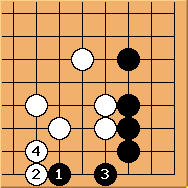
Solution 1 : playing this way, White only get 7 points in sente ; can you find where ?
| |
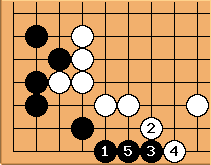
Solution 2 : here, only this sequence works ; it is worth about as much as the usual monkey jump...
| |
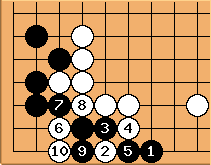
... which would be cut
|

Solution 3 : the monkey jump would only kill by ko.
| |

Solution 4 : here, the ultra long jump cannot be cut.
|
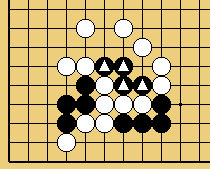
 (?) Problem 1 (the raccoon tesuji) : Black to play and save the marked stones (?) Problem 1 (the raccoon tesuji) : Black to play and save the marked stones
|
The tesuji "of the raccoon drumming on his belly" (Tanuki no hara tsuzumi ; as an even more pedantic aside, the "tanuki" is in fact the raccoon dog, Nyctereutes procyonides), the only way of unconditionnally saving the stones in Problem 1 (from Segoe's tesuji dictionary), is probably the least known of the "basic tesujis" (I may even have been unfair in judging Problem 1 worth only one  ) ; it is nevertheless the only refutation of many joseki traps (hamete)... ) ; it is nevertheless the only refutation of many joseki traps (hamete)...
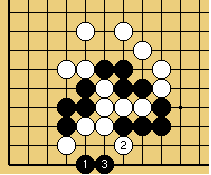
Solution : this is the only way to prevent a ko
|
The first line tesuji of problem 2, already quite astonishing, appears at move 17 in the main sequence (and cannot be played earlier); one could think it is humanly impossible to find it without moving stones around. Yet, I saw one of the best Chinese professionals solve it (at Terschelling EGC, in 1985) a few seconds after I ended drawing it on the tablecloth of the restaurant where we ate. He grumbled that he didn't like these kinds of problems ("one-way street", too easy), then showed us a few of what he called decent problems ...

Solution 1 (6 at 3, 15 at 13) : Black connects by the first line (watari) or wins the semeai
|
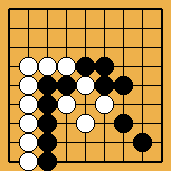
  Problem 3 : Black to play and capture the 4 white stones (without ko) Problem 3 : Black to play and capture the 4 white stones (without ko)
|
At first sight, problem 3 doesn't look very hard. But in fact, shortage of liberties (damezumari) appears in all natural tries, and the correct sequence, known jocularly as the "pear and ant manoeuvre" (ari-nasi, a japanese wordplay with meari-menashi) is quite surprising...
| 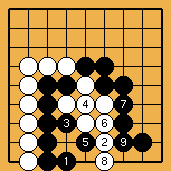
Solution 3 : again, Black connects or wins the semeai
|

   Problem 4 : Black to play and live
Problem 4 : Black to play and live
| Problem 4 (a classical Chinese composition from the Xuan Xuan Qi Jing, and called "In danger, look for opportunities", amongst other names) displays a surprising duel on the first line, building a "take-back tesuji" (torikaeshi) whose function is to slow down the final approach of White. But even knowing this, you will have merit if you solve it ...
|
|
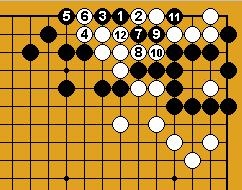
Solution 4 : first line preliminaries |

Solution 4 (conclusion): Black can refuse the ko fight, and be there just in time for the ishinoshita (15 at 1, 16 at A, 18 at 14, 21 at B).
|
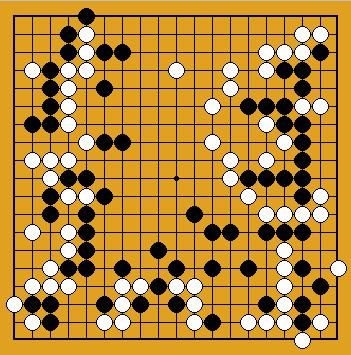
    Problem 5 : White to play and kill the NE group
Problem 5 : White to play and kill the NE group
|
Problem 5 is another ultimate task in the Hatsuyoron, a long sequence of "bridging" moves (watari) on the first line and of shortage of liberties tesujis (marvel, for instance, at moves 14, 36, 52, 60), with a nice semeai problem along the way : 23 liberties against 25 (after move 65), and a fitting conclusion, still on the first line, with a starting (and startling) tesuji similar to the one in problem 2 ...
|
|
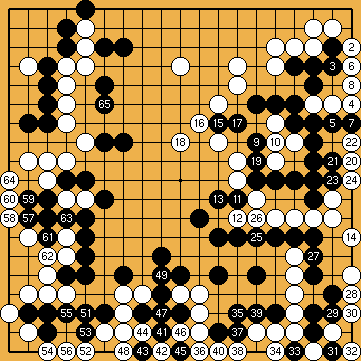
Solution 5 : first part (50 at 42); after 65, White couldn't win the semai...
| |

Solution 5 : conclusion
|
Click here for an animated solution
Back to the table of contents
2. Shortage of liberties (damezumari)
Being short of liberties is a pervasive and well-known concept of the game, and tesujis using it are usually in the toolbox of every confirmed player. Nevertheless, some applications of damezumari look really paradoxical, allowing for seemingly impossible tricks, like some of the double snapbacks of section I.2, or the art of cutting bamboo joints (which will be demonstrated in subsection 4). Here, we will have a look at a few of the lesser known manoeuvres...
To give a stone to the opponent by means of a throw-in, hoping he will choke on it, is a well-known idea, known (in Japanese) as horikomi ; it is a frequent preliminary to
thieves' play. But some horikomis are quite well hidden, like the one in Problem 1, nicknamed the Z, or Zaza's (Michel Zaltzman) problem ; Problem 2 is a miniature using the same idea, whose only interest is the blind spot key. Problem 3 is a more elaborated application, for which we are indebted to Saijo Sensei, who fanned himself with it during a whole Federation summer camp, often under the nose of Zaza... who couldn't solve it. You, on the other hand, should succeed easily, now that you know the theme...
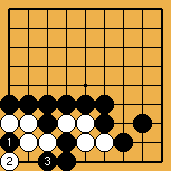
Solution 1 (the Z key) : this sacrifice alone kills without ko
|
|

Solution 2 : this 1-1 point sacrifice is quite exceptional...
|
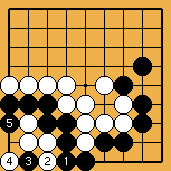
Solution 3 : after the slow key 1, the same tesuji
prevents White to make two eyes (at least by ko) in the corner ...
| |

... in both variations
|
(the key is a probe (see the Appendix). Note that tries at playing on point 1-2 immediately are refuted by the opposite 3-1 move)
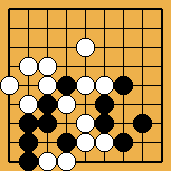
 Problem 4 : Black to play and save the corner stones Problem 4 : Black to play and save the corner stones
| |

 Problem 5 : The closed L-group with 2 liberties ; Problem 5 : The closed L-group with 2 liberties ;
Black to play and live
|
In many cases, shortage of liberties leads to an impossible connection, either because it would only give more stones to the opponent (this is oiotoshi, or thieves' play, Problem 4), or because the connection is definitely prohibited by the rules (this is oshitsubushi, or squashing, Problem 5. Note that even if suicides were allowed, this would not change the status, as it would be Black's turn to play after the self-capture of the 4 white stones ...).
|
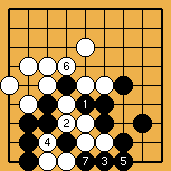
Solution 4 : White cannot connect all its weaknesses
| |
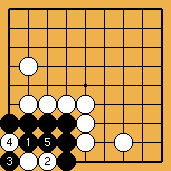
Solution 5 : the squashing manoeuvre gives two eyes (even if suicides are allowed)
|
The squashing phenomenon has a lesser known, but much more spectacular effect in what I have called the "2 and 3 combination", constructing two eyes after the simultaneous capture

  Problem 9 (reference position) : Black to play and live (without ko) Problem 9 (reference position) : Black to play and live (without ko)
| |
|
|
The "reappearance of the second eye" (perhaps I should have called it the Lazarus manoeuvre) is another rather astonishing shortage of liberties theme, of which the reference position on the left, and problems 10 and 11 give a nice illustration : it is the only refutation of the 1-2 point attack on the "carpenter's square" (without liberties), and our master, Lim Yoo Jong, told us that the best medieval players had misjudged that attack, believing the shape to be dead until someone found this manoeuvre.
|
|
|
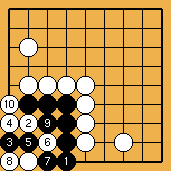
Solution 9 (11 at 5) : in spite of its own shortage of liberties, the black group rises from the dead (note that one must refrain from the usual sacrifice of 9 at 5)
|

  Problem 10 : Black to live Problem 10 : Black to live
|
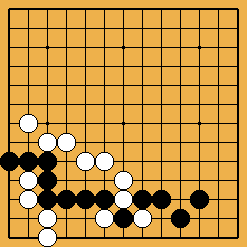
  Problem 11 : Black to live Problem 11 : Black to live
|
Soon after I had learned this trick, problem 10 appeared in the monthly solving competition of Kido. I was rather proud of having solved it in less than 5 minutes, being then around 1-kyu, so I was both impressed and disappointed to watch our master solving it in about 20 seconds... As for problem 11, it is rather difficult, because it seems reasonably easy to capture the inside white stones, but the fact that this doesn't give life to Black comes as a nasty surprise ...
|

Solution 10 (11 at 3, 12 at 1, 13 right of 8) : here again,
one must not play the usual sacrifice (7 at 3). Playing 5 at 8 gives only a ko (in spite of the pretty under-the-stones play), and I obviously prefer this almost double snapback conclusion...
|

Solution 11 (13 at 3): here again,
one must not play the sacrifice ...
|
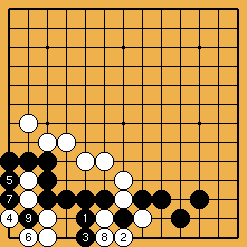
It seems easy to kill the corner group (10 above 9), but in fact it is Black who dies then (eye against no eye, then rabbity six...)
|
|
The last interesting damezumari theme I will show here is what I called "suction" (as when drinking through a straw), or vacuum-cleaner effect (it is often combined with thieves' play) : this works by forcing the opponent to create a too long chain (three stones on the first line, for instance), whose capture makes an eye (in contrast with capture of two stones). The life of the L-group, on the right, is a classical example.
|
|

 Example 12 : Black to play and live Example 12 : Black to play and live
|
|

Solution 12 : after suction, the capture of three stones (if White connects above 2) would gives a second eye
|
The two problems below, from Hatsuyoron, are amongst the most difficult on this theme
In problem 13, a few preparatory moves (whose order seems more important than was thought : the recent Chinese analysis shows that the one given here, from Japanese books, is wrong), followed by a sacrifice of two stones hard to find (and even to understand), sets the stage for an unusual corner tesuji, which we saw in the ending of Nakayama's problem. As for problem 14, an all-time favourite of André Moussa, the vacuuming up to the marked stone looks completely impossible at first (and even second) sight; moreover, after the preliminaries, the key (move 11) is all the more strange and hard to find in that it doesn't seem to protect the cut...
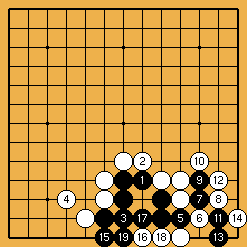
Solution 13 ; here is (in French) a more exhaustive solution, due to Noguchi Motoki ; the Chinese version of Hatsuyoron says 1 and 3 should be switched...
|
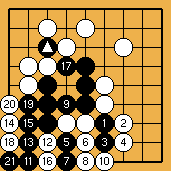
Solution 14 ; here is (on my site, and in French) a more detailed solution ; another Chinese criticism is that 12 would be harder to counter if played at 18
|
Back to the table of contents
3. Off-limits moves and phantom go
The tesujis of this section look misplaced at first sight, either because they seem too far from the immediate fight, or because they are apparently played in blissful ignorance of enemy stones...
Weak players are often unable to imagine moves behind the "obvious" boundary, perhaps because they are afraid of being cut : in Problem 1, you must strike twice at the keima hinges to capture the second-line stone. But even strong players will easily miss similar tesujis in positions like Problem 2 (a variation of a 5-4 point joseki), where the most efficient way of getting out starts with a seemingly absurd move (working as the better known driving tesuji of the reference joseki in Problem 3).
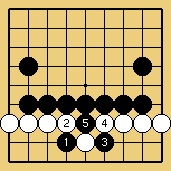
Solution 1 : White would rather play 4 at 5, to save something at least... |
|

Solution 2 : if White tries to resist, Black lays waste to the side |
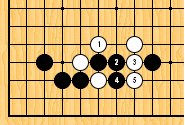
Solution 3 : this technique, the driving tesuji, punishes the cut by destroying the outside stone |
The Japanese term of oki describes usually only moves inside ennemy territory, but can in fact be used for all those "off-limits" moves (French players often describe them as paratroop attacks). We have already seen spectacular examples (which could even be described as "off-topic" moves) in the symmetrical problems I.1.1 and I.1.3 ; note that the strange key of problem I.1.4 is a similar move on the opposite side of the apparent fight, with a defensive function. Of course, ladder-breaks (and ko threats) will be put in the same category only by complete beginners... but see problem III.6 and III.7 for exceptions to that rule.
The technique shown in Problems 4 and 5, which I call the roundabout manoeuvre, though quite useful to master in practice, will seem "off-limits" only to novices. On the other hand, the connecting tesuji of Problem 6 (which would almost be a refutation of the manoeuvre) is a true "off-limits" move, which few amateur players have in their bag of tricks...
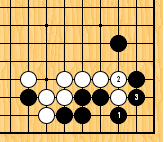
Solution 4 : move 1 is
the "roundabout manoeuvre"
| |

Solution 5 : here again, after move 6, Black is helpless...
| |
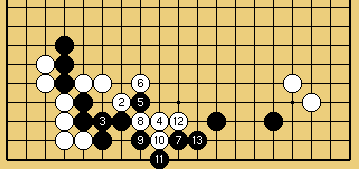
Solution 6 : here, the strange move 7 secures the connection...
|
Okis in the heart of enemy territory are well-known, even when they create subtler threats than being a mere nakade. But the external oki of the following problem might come as a surprise :
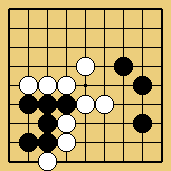
  Problem 7 : Black to play, status ? Problem 7 : Black to play, status ?
We were shown Problem 7 at the Paris tournament in 2007 ; it is a surprising example of a well-hidden tesuji in a light position. It is also a probing move, which gives me a good opportunity to let the reader think of the working of such moves, especially the reason why they must be played first, forcing the opponent to choose his reply too early ; so for once, I give all the variations...
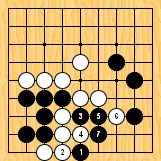
Solution 7a : the key is the (external) oki at 1 ; after the first-line connection, the ladder is broken | |
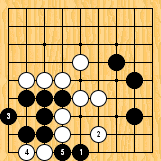
Solution 7b : if White simply connects here, the suction creates an eye in the corner | |
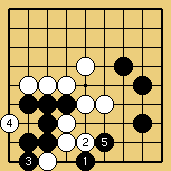
Solution 7c : this way of connecting with the help of damezumari (or thieves play) is another useful trick... |
The next problem (a Japanese improvement on a Chinese classic) shows a different way of playing "off-limits"...
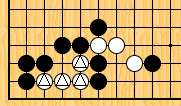
  Problem 8 : Black to play and capture the marked stones Problem 8 : Black to play and capture the marked stones
This time, all reasonable moves are in fact "too far" (as in Problem 1.3) ; the solution is a succession of three apparently contradictory moves on both sides of the boundary, similar to the phantom go sequences we will see next...
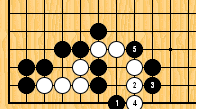
Solution 8 : the atekomi 5 ends all White hopes...
The strangest off-limits sequence of my collection is nevertheless a recent discovery : it was drawn to my attention in spring 2008 by Thomas Cabaret (a promising young player from the club in Cannes) ; it actually appears in Xuan Xuan Qi Jing, but you must be a pro if you did already notice its unusual features without solution diagrams...

   Problem 9 : Black to play and save the 6 stones on the side Problem 9 : Black to play and save the 6 stones on the side
After a forced sequence, reasonably easy, but making the reading harder, and the solution almost impossible to find if you are not pro, the first tesuji (move 9, but it can actually be played earlier) is a nice guzumi (efficient empty triangle) threatening two ladders, but White seems out of trouble with the counter-tesuji (a shoulder-hit breaking both ladders) ; and now, who could find the two following off-limit moves ?
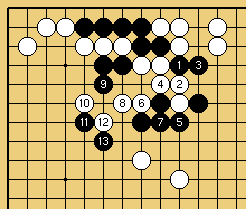
Solution 9 : 12 is the strongest resistance, but after 13... | 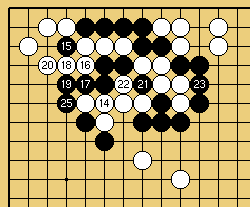
... White must chose one side, or connect ;
checking the other options is left as an exercise to the reader... |
We'll meet other examples in the next section ; we will now look at a few sequences played as if the opponent's stones were not there. If you have participated in an European Go Congress, you may already have met phantom go, a kind of blind fighting using the rules of our game ; many similar weird sequences can often be seen there, to the merriment of onlookers...

  Problem 10 : Black to play and live Problem 10 : Black to play and live
Problem 10 is one of the recent Korean training problems ; Black, to save her stones, must go through the white wall like a ghost...
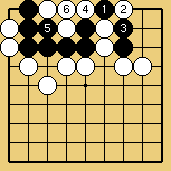
Solution 10 (7 at 1, 8 at 4) : this is the only way to live unconditionally...
| |

... this more natural sequence (4 at 1, 6 at 1, 10 at 2) only succeeds in making false eyes ! |
Even stranger things may happen, making one believe that one player is sacrificing his stones at random, as for instance in problem I.7.1, or with "reappearances of the second eye" ; the following nice problem, surprisingly hard for such a light setting, was another pleasant surprise of Paris 2007.
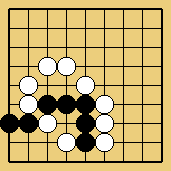
   Problem 11 : Black to play, status ? Problem 11 : Black to play, status ?
In Problem 11, it is already not easy to live in the corner, or to find a ko. But it is possible to do even better...
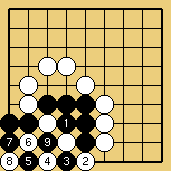
Solution 11 : after many random-like moves, Black lives in double ko
Back to the table of contents
4. Impossible cuts (atekomi, warikomi, etc.)
Beginners discover usually quite early that they had better not let their groups be cut ; this tends to make them create heavy shapes, and we saw in the previous subsection that it also often prevents them from finding moves which are (for them) "off-limits". They also learn fast that some shapes are safe (except for the occasional oversight) ; bamboo joints, kosumis and even tobis are usually quite satisfyingly solid, which allows one to relax somewhat. We'll see in this subsection that not only must one stay careful (as those so-called impossible cuts sometimes work nevertheless), but that a more subtle use of cutting threats can also have paradoxical and spectacular consequences...

Figure 1 : Atekomi
|
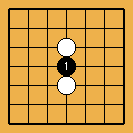
Figure 2 : Warikomi
|
|
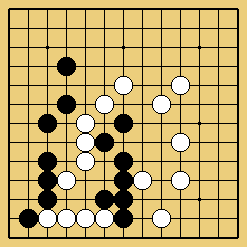
(no star) "Problem" 1 : Black to play and save her surrounded stones.
|
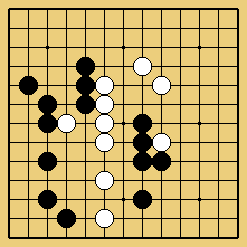
 Problem 2 : Black to play and cut off part of the white group Problem 2 : Black to play and cut off part of the white group
|
|
When a seemingly quiescent position crumbles, as is the case in Problems 1 and 2, respectively showing atekomi and warikomi cuts ...
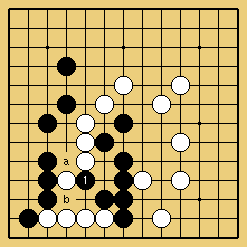
Solution 1 : after the atekomi move 1,
White cannot protect both cuts at a and b
|
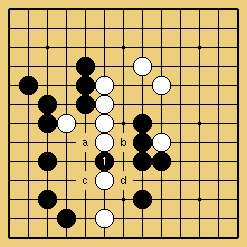
Solution 2 : after the warikomi move 1, whatever answer White chooses
allows one of the four cuts at a, b, c or d
|
|
... the player is sometimes destroyed too : our master used to tell us that one of his friends, playing in a Korean club, had once suddenly cut a group (by a similar atekomi) into two one-eyed pieces, killing it, but alas, shocking so much his elderly opponent that the latter died too (from an aneurism). He had trouble clearing himself in the subsequent police enquiry, after a confused start ("Well, I killed him by playing there...'), and Lim concluded his story, in his inimitable broken French : "When you play old man, you must play very soft..."
In fact kosumi and tobi cuts can happen because the first attacking move may at times create more cutting points than can be mended. Bamboo joints suffer from a different hidden weakness : there are in fact no liberties at the joint, so damezumari and thieves' play may happen. Problem 3 illustrates this :
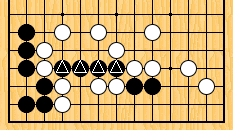
 Problem 3 : Black to play and save the marked stones. Problem 3 : Black to play and save the marked stones.
The paradoxical idea of Problem 3 is to create a bamboo joint only to then cut it...
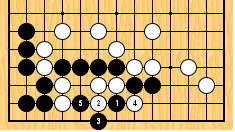
Solution 3 : if White instead connects (4 at 5), then Black connects at 4 and wins the race.
We'll see now that cutting is not the only objective of these moves :
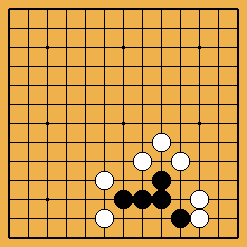
   Problem 4 : Problem 4 :
Black to play and live or escape
The wedging tesujis (that's the implied meaning of the Japanese suffix komi, as in atekomi, threat to cut a kosumi, figure 1, or warikomi, direct cut of a tobi, figure 2, and words like horikomi also exist) often have results more complex and spectacular than a mere cut ; the most beautiful example I know is Problem 4 : the key (an outside atekomi, so this is an off-limits tesuji too) is a probe (yosumiru, but see here for this "translation"), opening up four distinct weaknesses.

Solution 4a
| |
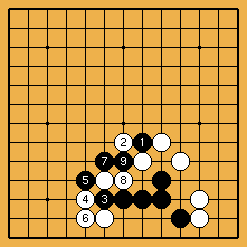
Solution 4b
|

Solution 4c
| |
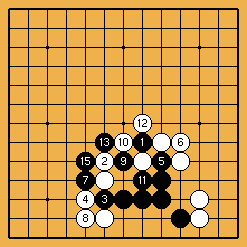
Solution 4d (14 takes the ko) : this is the strongest resistance, but... (actually, there is a refutation of this line of play ; see the text);
|
The following problem was Kobayashi Chizu's favorite, because she got it, and solved it, as a Christmas present when she was seven (I show here a simplification of the original in Xuan Xuan Qi Jing, which also needs a non-obvious fighting race to be read and solved). Will you be able to do the same ?
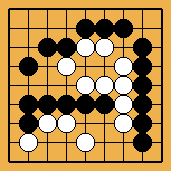
  Problem 5 : Black to play and capture the largest white string. Problem 5 : Black to play and capture the largest white string.
Here again, the atekomi is a probe :

Solution 5a : this way,
Black captures everything. | |
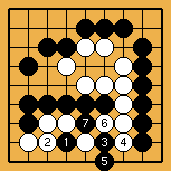
Solution 5b : this way, the small group lives in the corner. |
The following miniature is a recent Korean composition ; see on this (in French, alas) my page of Korean problems.

  Problem 6 : Black to play and live. Problem 6 : Black to play and live.
Even knowing the solution is an atekomi, finding it may give you trouble. The order of moves is essential ; I let you discover what happens in the other possible answers, and why one must not begin by making the first eye in sente. This strange way of starting the fight will appear again in some 4-group problems of the semeai section.

Solution 6 : After Black creates damezumari on herself, White has no way to prevent the capture of the two corner stones.
To conclude, you will find in the following section a beautiful (and well-hidden) atekomi for yose, said to have been played in a real game by Honinbo Shusai (-but this doesn't appear in the records), and another one, well hidden too, which was nicknamed the Meijin's sorrow, because Honinbo Shuho could not find it during the game...
|
If the atekomi is obviously a paradoxical tesuji (it threatens to cut the uncutable), the same cannot be so clearly said of the warikomi, even if every experienced player knows that 'one doesn't cut (ikken) tobis'. Besides examples of real cuts, as in Problem 2, one can nevertheless find some classical shapes, like the one in Problem 7, where this move works without many complications (even though it can easily become a blind spot for strong players)
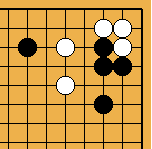
 Figure 7 : Figure 7 :
Black to play and exploit White weaknesses.
|
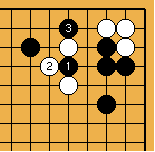
Solution 7 : this captures the corner ;
if White refuses the sacrifice, Black connects her stone and gets a nice influence. |
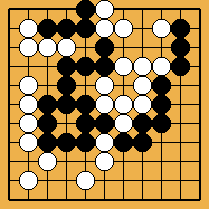
  Problem 8 : Black to play and live (and what happens then to the white group ?). Problem 8 : Black to play and live (and what happens then to the white group ?).
On the other hand, the warikomi of problem 8 is more hidden, and one can then easily miss the nice ishinoshita resistance, after which the killing of both groups becomes impossible.
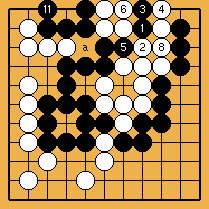
Solution 8 : After the under-the-stones play (7 at 1, 9 at 3, 10 left of 1), White cannot cut at a any longer ! |
But, for hidden simplicity, there is no way anything could ever replace my all-time favourite warikomi, the one (almost) played by Dosaku. Before you see it (in section 6), we'll conclude this section with one of the best problems I know, introducing a "virtual" warikomi theme, and for the starting key an unthinkable move, then making good use of almost all the ideas we have just seen...
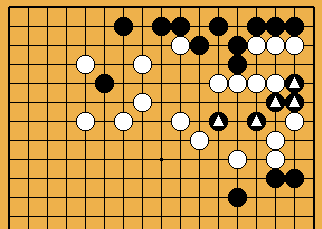
   Problem 9 : Black to play and save the marked stones. Problem 9 : Black to play and save the marked stones.
This bewildering composition from Hatsuyoron would justify many commentaries and solution diagrams. First, nobody could imagine the key move : a tobi connection in empty space, threatening a cut, but whose main function is to protect from a warikomi, while keeping the maximum number of liberties (winning the semeai in some variations). Next follows a typical phantom-go sequence, with apparently unplayable hanes (the last one being also a warikomi), and then a geta ending all Black's hopes... until she finds the external atekomi which concludes this gem.
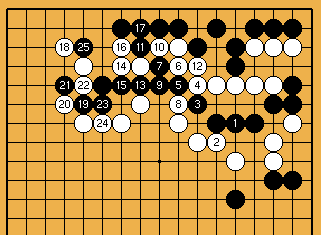
Solution 9 : all this is beyond commentaries, especially move 1, but I would still like to draw attention to the absurd character of 7 (also called a warikomi, by the way)...
|
Back to the table of contents
5. Traps and variations of joseki
The last sections are examples of strange tesujis and sequences actually played, or at least studied because they could appear in current josekis...

A very old joseki
|
Starting from this very old joseki (4 doen't even appear any longer in modern dictionnaries), Kaizen, a very strong amateur player of the late 18th century, discovered an extraordinary sacrifice sequence, ending in a tremendous influence. This goes to show that "josekis" spreading over half the goban were not unknown before the young modern Korean players...
|
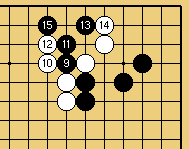
   Position 1 : before Kaizen's great surrounding. Position 1 : before Kaizen's great surrounding.
If White tries to capture the weak black cutting stones...
|
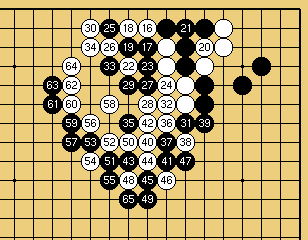
he falls under a succession of shiboris (squeezes) ending in a frighteningly thick wall
|
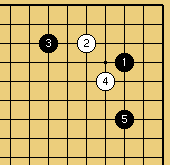
  Position 2 : start of the 19 points trap. Position 2 : start of the 19 points trap.
|
Black 5 looks suspicious, but to refutate, White must simply pull back (solution below). If he goes for the kill, White gets invoved in a bewildering sacrifice sequence (shibori), from which there is no escape...
|
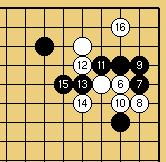
If White tries
to capture the corner...
|

...he succeeds (24 at 19),
cashes 19 points (in gote) and loses at once the game !
|

Solution : it is enough to force Black to crawl to defuse the trap...
|
Back to the table of contents
6. Extraordinary moves played in actual games
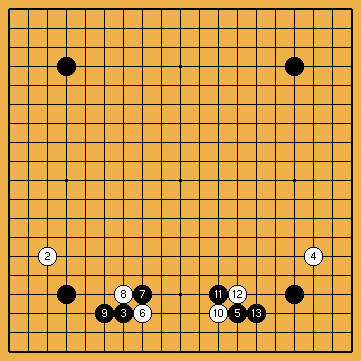
   Position 1 : how would Dosaku wrap up the game ? Position 1 : how would Dosaku wrap up the game ?
(click here for an sgf file of the solution) |
The extraordinary idea of position 1 came to Honinbo Dosaku against the Peichin of Hamahiga, best player of Okinawa (this was
the first international encounter, in 1682, for which we have game records), where he played at 4 handicap stones. These corner sequences, beside being natural ones, were at that time joseki, but they combine incredibly badly in this situation. This tesuji would have immediately ended the first game, because after move 18, the Peichin (who was in fact quite a strong player) would understand at once that resistances like the one shown here would only serve to expose the almost complete destruction of the handicap in less than 20 moves... except it was never played (and was only shown by Dosaku in the commentary), as the Peichin carefully played the hane under 10 to break the symmetry at move 11... which didn't prevent him losing the game.
|

This incredible tesuji...
|

leads ineluctably to something like this frightening shibori (squeeze sequence)
|
What follows is another famous historical game, played between Honinbo Shuwa and Gennan Inseki (in 1842). It is extremely spectacular (
click here for an animated record), but I show it here only because of the yose trap that Gennan, seeing he had lost, tried to spring on Shuwa, and which was not played to the end, both players being respectful of the reading capacities of the opponent...

Moves 1 to 100 (the ko fight is not shown)
| |

Moves 101 to 200 (the ko fight is not shown)
|
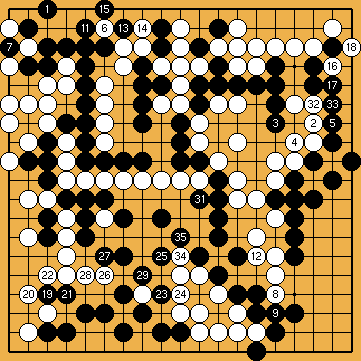
Moves 201 to 235
|
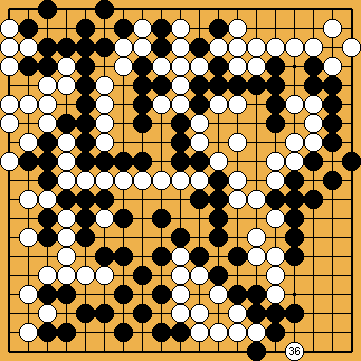
   Position 2 : what is the threat behind this move? And how to answer? Position 2 : what is the threat behind this move? And how to answer?
| |
Gennan, calculating he was losing by 1 point (which is already quite unbelievable...), tried (position 2) this astonishing yose trap (another off-limit move). It is easy to see that not connecting costs at least 2 points (for instance in the pretty sequence 1). But what must Shuwa have anticipated to be confident enough to kill (without ko) if Gennan followed as in the game, then blocked 67 ? An impressive display of reading power, isn't it ? |
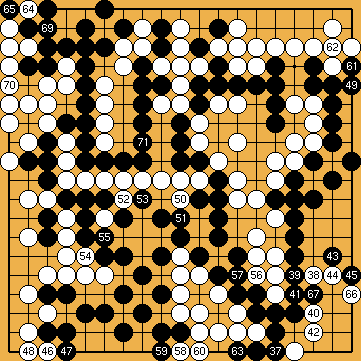
The end of the actual game : Gennan loses by 6 points, after his "blunder"
| |
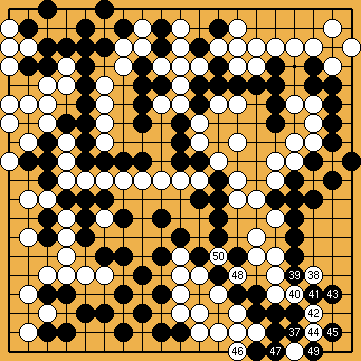
Sequence 1 : the "obvious" branch of the trap : Black loses at least 2 points and the game
|
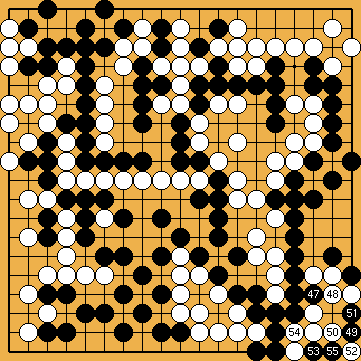
Sequence 2 : the right resistance : 53 is the famous "unplayed tesuji"
|

  Position 3 : Black to play and wake up the corner aji Position 3 : Black to play and wake up the corner aji
This nice yose tesuji was played by Shusai in a real game (well, I am no longer sure of that : it doesn't appear in the records we have of his official games) ; I wonder if White was not looking for a place to resign (it seems rather odd that a high-level professional, playing under no time constraints, could have missed it), unless they both thought this was the normal yose, everything including the ko being anticipated...
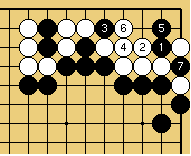
Solution : after the atekomi at 1, White must play the ko (or else, if 2 at 5, 3 at 4)
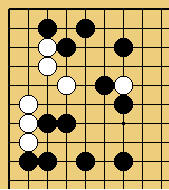
   Position 4 : Black to play ; status? Position 4 : Black to play ; status?
On the other hand, in position 4, both players (Honinbo Shuho and his opponent Kobayashi Tetsujiro, in 1884) missed the unconditional death of the white group (one must admit it is well hidden in a seemingly simple shape) ; this (double) blunder was nicknamed "the Meijin's sorrow" (as Shuho, who never actually became Meijin, was regarded as worthy of being it).
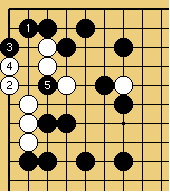
Solution : after 1 and 3, already not obvious,
the atekomi 5 is hard to spot... | |
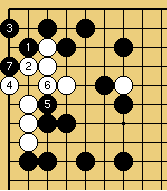
The sequence actually played :
White dies in ko... |
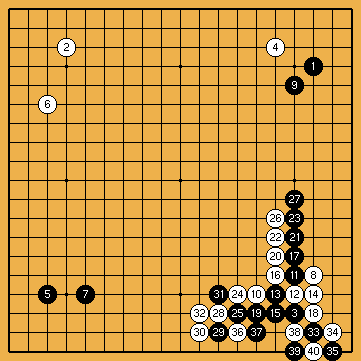
  Position 5 (the trap) ; what happens if Black plays the "natural" ko threat above 31? Position 5 (the trap) ; what happens if Black plays the "natural" ko threat above 31?
|
And, last, the most famous move in go history, played by the young Shusaku (in 1846), and which reddened the ears of Gennan. First, contemplate the fiendish trap laid in the beginning by Gennan in a taisha variation, which almost destroyed Shusaku (25 must be played at 29, as the actual sequence played is then a one-way street, and forces Black to use the bad threats 41 and 47) :
|
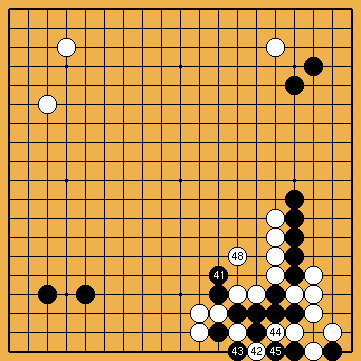
White would then play this devilish sequence (46 at 42, 47 at 45). And where did the ko disappear ?
|
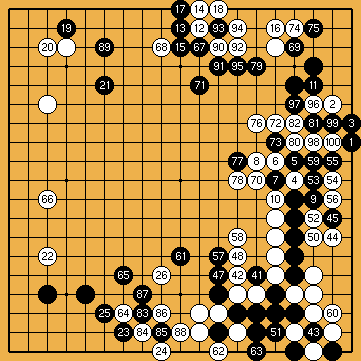
    Position 6 (before the ear-reddening move) : and now, what did Black do? Position 6 (before the ear-reddening move) : and now, what did Black do?
|
Though he was now falling behind because of the bad threats, Shusaku played optimally up to move 125 (the game displays some other frightening sequences, which you will find commented in Invincible, for instance the squeeze beginning at move 81 and in which the stone 45 plays a miraculous role in preventing the disaster). Gennan then attacked the lower group by playing 126, and at this moment, all the observers agreed he was winning (by a few points) when...
|
|
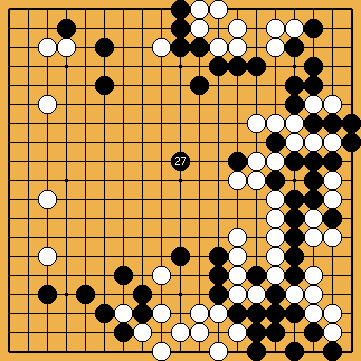
The ear-reddening move, most famous move ever
|
...Shusaku found the extraordinary move 127, the "150% efficient move". A doctor in the (adjacent) room then made aloud the observation that Gennan would lose, saying he had seen his ears redden with the shock of seeing the move ...
|
|

The end game (moves 128 to 227)
|

Last moves : Black (Shusaku) wins by 2 points (and not 3 as usually
written ; this was discovered around 1950 by a Japanese amateur)
|
Click here for an animated record of the game
Back to the table of contents
Back to Part 1
To Part 3
| |